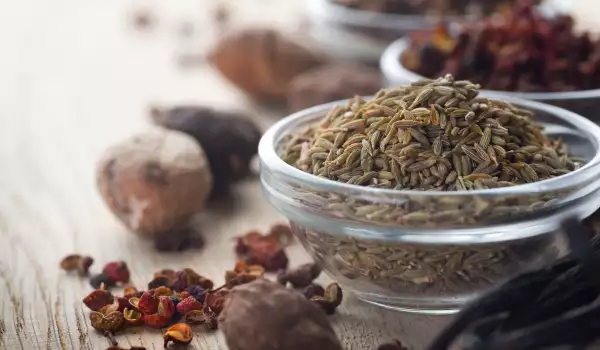Since the time of Egyptian pharaohs, through the Middle Ages and all the way up to today, cumin is one of the most famous spices, which has a wide use in the kitchen. Cumin is distinguished by a bold smell and specific intrusive taste, which is especially appropriate in meat dishes. Nowadays, cumin is often added to various sausages of ground and minced meat, as well as to homemade sausages and blood sausages.
It is best to add cumin that is ground or powdered to them. The taste of cumin can be felt in the ingredients of curry and garam masala, which shows that cumin is among the most loved and favored spices by Indians. Latino Americans and Arabs also have an affinity for the unique taste of cumin.
Down to its core, cumin is a perennial or biennial essential oil plant - growing both in the wild and cultivated. Its Latin name is Cuminum cyminum, and it belongs to the same family as parsley and carrots - Apiaceae. Cumin roots are thick and fusiform. During their second year the roots reach a 0.8″ (2 cm) thickness and 3.9″ (10 cm) - 7.9″ (20 cm) length. The stem grows 7.9″ (20 cm) – 11.8″ (30 cm) tall, highly branched, hollow and with thin ridges along the length. The leaves are pinnate and thread-like.

The flowers of cumin are distinguished by their small size, being white or pale pink in color. Usually, the fruit is brownish, flat on the sides and with ridges longitudinally. Some of the ridges have growths, composing the fruit of 2 halves. During blooming, the two halves separate from each other, hanging on only by the lower part of the pedicle. It is best to only use the unripened fruits of cumin. Once they do ripen fully, they fall off easily and therefore you should not wait for them to do so.
Cumin blooms mainly in May - June. The fruit is ready for picking once it becomes dark brown in color. The dried seeds of cumin have a characteristic, strongly aromatic smell and an acrid taste. Its chemical composition is 3-7% essential oil, 13-16% fatty oils, proteins and others.
History of cumin
The popularity of cumin as a spice has been known since back in ancient Egypt. Proof of this is the discovery of cumin seeds in ancient Egyptian tombs. Cumin seeds are even mentioned in the Bible. Later, during the time of Roman emperors, cumin was treated not only as a spice but as a medicinal plant.
Pliny wrote how Nero was betrayed by one of his subjects, who had been taking infusions of cumin, which causes serious skin pallor. The tortured, pale likeness of skin of the Roman subject caused Nero to agree to all of his demands.
The birthplace of cumin are the lands of central Asia but today it is mostly grown in the Mediterranean countries, where it was originally cultivated. The largest plantations of cumin are found in Morocco, Egypt, India, Syria, North America and Chile.

Composition of cumin
Cumin contains essential oils, protein, fats, tannins, resins, the flavonoids kaempferol and quercetin. The aerial part of the plant also contains kaempferol and quercetin, as well as isorhamnetin.
Uses of cumin
Latino Americans, as well as Arabs regularly use cumin to season their dishes. It is also applied in the sausage industry, since it contains excellent preservation properties.
Cumin is often used to flavor bakery goods. It is a mandatory spice in the preparation of minced meat, sauerkraut with meat, cabbage with rice, grilled food items, salted biscuits and others. As well, it is an ingredient used in the creation of various liquors.
Benefits of cumin
Folk medicine has been applying the positive benefits of cumin to the human body for a long time. It is proven that cumin has carminative, cholagogue and nerve calming effects. These beneficial effects are connected to the digestive system.
It stimulates appetite, as well as stomach, pancreatic and biliary secretion, while at the same time relieving spasms and expelling gas from the intestines. Cumin can increase breast milk production and has an anti-inflammatory effect on the airways. Essential oils from the cumin plant help to increase and harmonize the defenses of the body.
Essential oils from cumin are also very beneficial against various allergic conditions. The processes for strengthening the immune system are accompanied by the capacity to combat hypersensitivity and allergic reactions. Cumin is a proven weapon against dust and pollen allergies, as well as against neurodermatitis.
Furthermore, cumin oils decrease blood sugar levels and show a bactericidal, anti-inflammatory and anodyne effect. Cumin oils have a favorable action during menstrual problems too. Cumin seeds contain iron and are good for the liver.
Dangers of cumin
Cumin has the capability to irritate the glands of the digestive system and to stimulate appetite. It is not healthy to intake large amounts of the spice because it can cause inflammation of the stomach lining.




















